Título
Physical Activity Levels and Sleep in Schoolchildren (6–17) with and without School SportAutor-a
Autor-a (de otra institución)
Fecha de publicación
2023Otras instituciones
Universidad de DeustoMugikon
Athlon Koop E.
Universitat Ramon Llull
Kirolene: Kirol Irakaskuntzen Ikastetxe Publikoa
Universidad Euneiz
Versión
Version publicadaTipo de documento
ArtículoArtículoIdioma
InglésDerechos
© 2023 by the authors. Licensee MDPI, Basel, SwitzerlandAcceso
Acceso abiertoVersión de la editorial
https://doi.org/10.3390/ijerph20021263Publicado en
International Journal of Environmental Research and Public Health vol. 20, issue 2, 1263.Editorial
MDPIPalabras clave
Physical activity
Sleep
Schoolchildren
Sedentary behaviour ... [+]
Sleep
Schoolchildren
Sedentary behaviour ... [+]
Physical activity
Sleep
Schoolchildren
Sedentary behaviour
School sport
Accelerometer [-]
Sleep
Schoolchildren
Sedentary behaviour
School sport
Accelerometer [-]
Resumen
There is strong evidence to support the association between daily physical activity and sleep
parameters in children and adolescents. Physical activity and outdoor play are favourably associated
wit ... [+]
There is strong evidence to support the association between daily physical activity and sleep
parameters in children and adolescents. Physical activity and outdoor play are favourably associated
with most sleep outcomes in school children. The aim is to find out the levels of physical activity
and the quality of sleep in Basque schoolchildren aged between six and seventeen and to analyse the
possible differences between those who carry out some kind of physical sports activity and those
who do not. The sample consisted of 1082 schoolchildren (50.1% male and 49.9% female). Differences
between groups were compared using the Mann–Whitney U test (2 samples) and Kruskal–Wallis
one-factor ANOVA (k samples). A total of 723 (66.94%) of the participants said they practiced some
physical sports activity. The accelerometers obtained significant differences in all levels of physical
activity, as well as in sleep efficiency, with higher levels of physical activity (sedentary p = 0.001;
light p = 0.017; moderate p = 0.009; vigorous p = 0.001 and moderate-to-vigorous physical activity
p = 0.002) and better sleep efficiency (p = 0.002) in those schoolchildren who perform some type
of physical sports activity. A significant difference in time spent in sedentary activities was also
observed between primary and secondary school pupils of both sexes and regardless of the degree of
physical sports activity completion. [-]
Sponsorship
Basque Government, Department of Culture and Linguistic Policy, Department of Health and Department of EducationID Proyecto
K-09/2020Colecciones
- Artículos - Educación [135]
El ítem tiene asociados los siguientes ficheros de licencia:






















